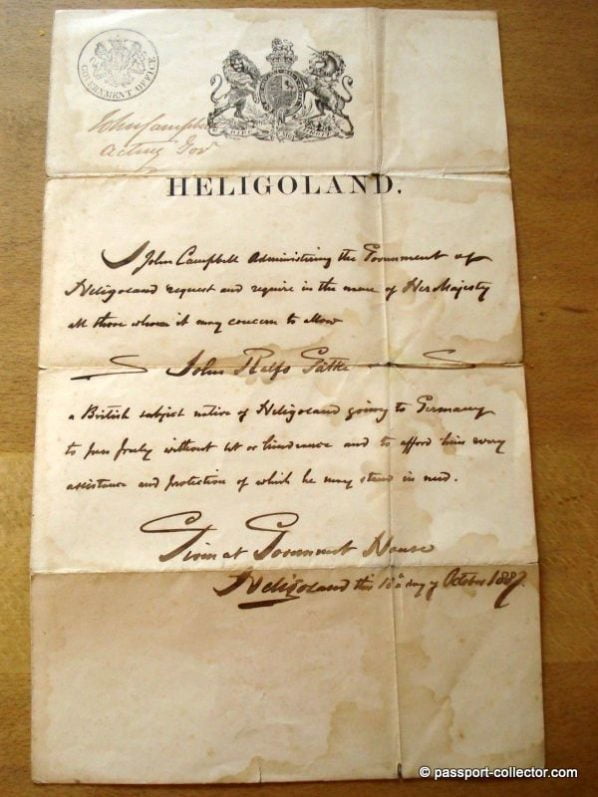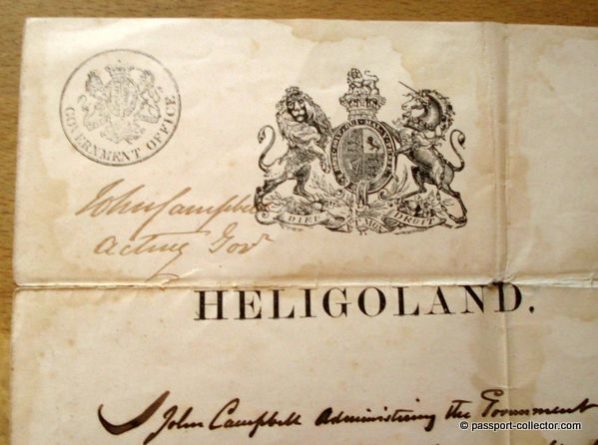Heligoland Passport • Government House 1881
Heligoland Passport • Government House 1881
A handwritten Heligoland Passport issued at the Government House in 1881 is something outstanding for the passport history of the British Empire. In 1881 the population of the small German archipelago in the North Sea was only 2000 citizens. The islands were at one time Danish, then British and since 1890 German. But who was holding a passport back then? Surely only a fraction of the island population. And how many of these Heligoland passports survived the time? Not many as in 15+ years of collection and research I only saw three of these documents, including the one displayed here. I also know where the other two are located. One is with a Heligoland collector in Canada (issued 1873) and another with a passport collector in the USA (issued 1864).
The Passport Handwritten Heligoland Passport
JOHN CAMPBELL administering the Government of Heligoland request and require in the name of her Majesty all there whom it may concern to offer JOHN RALFS GÄTKE a British subject native of Heligoland going to Guernsey to pass freely without hindrance and to afford him every assistance and protection of which he may stand in need. Handwritten Heligoland Passport
Given at the Government House
Heligoland the 18th day of October 1881

I couldn’t find any more information about acting Governor John Campbell, but according to records, John Terence O’Brien became Governor of Heligoland from 26 October 1881 till 1888. Just a few days after the passport was issued. This might be an explanation why the passport does not have the signature of an (acting) governor.


Thanks to the Heligoland specialist Serge Houde, who recognize the handwriting, I can add much more detailed information to this beautiful and rare travel document. According to Serge, the writing is of Heinrich Carl Ludwig Gätke. Gätke worked as a Town Clerk and became Government Secretary in the British Administration of Heligoland. His wife was the daughter of the British Colonel Hammond Ashley Tapp and the Helgolander Christine Payens. They had together ten children, and Gätke remain all his life on Heligoland.
 Gätke learned oil painting as an autodidact. Gätke’s paintings are influenced by German and English tradition, especially by John Constable and Carl Blechen. Numerous writers of his time, such as Theodor Fontane, Fanny Lewald, and Adolf Stahr, used Gätke in their works because of his extraordinary appearance and strong form.
Gätke learned oil painting as an autodidact. Gätke’s paintings are influenced by German and English tradition, especially by John Constable and Carl Blechen. Numerous writers of his time, such as Theodor Fontane, Fanny Lewald, and Adolf Stahr, used Gätke in their works because of his extraordinary appearance and strong form.
After the climax of his artistic work, he turned to ornithology in 1843. This has a long tradition in Helgoland. Also, ornithology he learned as an autodidact. Heinrich Gätke, the painter from Brandenburg, is generally regarded as the founder of bird research on Helgoland. He attracted the attention of European ornithologists to this island and its unique significance for the study of bird migration. Handwritten Heligoland Passport
Gätke received several high-ranking national and international honors. He enjoyed an excellent reputation as an ornithologist until his death on 1 January 1897. His work, his scientific heritage, and his international reputation were the trigger for the foundation of the ornithological station Helgoland in 1910.
So, finding and Heligoland passport is already an auspicious day. But finding a Heligoland passport issued by such a key figure for Helgoland – Heinrich Carl Ludwig Gätke – is the jackpot.

Update 31 October 2018
Oh, lucky day. I even could get now the birth certificate issued by the Nikolai Church in Heligoland 1872 for the very same John Ralfs Gätke in the above passport. What a fantastic set! Handwritten Heligoland Passport

FAQ Passport History
Passport collection, passport renewal, old passports for sale, vintage passport, emergency passport renewal, same day passport, passport application, pasaporte passeport паспорт 护照 パスポート جواز سفر पासपोर्ट
1. What are the earliest known examples of passports, and how have they evolved?
The word "passport" came up only in the mid 15th Century. Before that, such documents were safe conducts, recommendations or protection letters. On a practical aspect, the earliest passport I have seen was from the mid 16th Century. Read more...
2. Are there any notable historical figures or personalities whose passports are highly sought after by collectors?
Every collector is doing well to define his collection focus, and yes, there are collectors looking for Celebrity passports and travel documents of historical figures like Winston Churchill, Brothers Grimm, Johann Wolfgang von Goethe. Read more...
3. How did passport designs and security features change throughout different periods in history, and what impact did these changes have on forgery prevention?
"Passports" before the 18th Century had a pure functional character. Security features were, in the best case, a watermark and a wax seal. Forgery, back then, was not an issue like it is nowadays. Only from the 1980s on, security features became a thing. A state-of-the-art passport nowadays has dozens of security features - visible and invisible. Some are known only by the security document printer itself. Read more...
4. What are some of the rarest and most valuable historical passports that have ever been sold or auctioned?
Lou Gehrig, Victor Tsoi, Marilyn Monroe, James Joyce, and Albert Einstein when it comes to the most expensive ones. Read more...
5. How do diplomatic passports differ from regular passports, and what makes them significant to collectors?
Such documents were often held by officials in high ranks, like ambassadors, consuls or special envoys. Furthermore, these travel documents are often frequently traveled. Hence, they hold a tapestry of stamps or visas. Partly from unusual places.
6. Can you provide insights into the stories behind specific historical passports that offer unique insights into past travel and migration trends?
A passport tells the story of its bearer and these stories can be everything - surprising, sad, vivid. Isabella Bird and her travels (1831-1904) or Mary Kingsley, a fearless Lady explorer.
7. What role did passports play during significant historical events, such as wartime travel restrictions or international treaties?
During war, a passport could have been a matter of life or death. Especially, when we are looking into WWII and the Holocaust. And yes, during that time, passports and similar documents were often forged to escape and save lives. Example...
8. How has the emergence of digital passports and biometric identification impacted the world of passport collecting?
Current modern passports having now often a sparkling, flashy design. This has mainly two reasons. 1. Improved security and 2. Displaying a countries' heritage, icons, and important figures or achievements. I can fully understand that those modern documents are wanted, especially by younger collectors.
9. Are there any specialized collections of passports, such as those from a specific country, era, or distinguished individuals?
Yes, the University of Western Sidney Library has e.g. a passport collection of the former prime minister Hon Edward Gough Whitlam and his wife Margaret. They are all diplomatic passports and I had the pleasure to apprise them. I hold e.g. a collection of almost all types of the German Empire passports (only 2 types are still missing). Also, my East German passport collection is quite extensive with pretty rare passport types.
10. Where can passport collectors find reliable resources and reputable sellers to expand their collection and learn more about passport history?
A good start is eBay, Delcampe, flea markets, garage or estate sales. The more significant travel documents you probably find at the classic auction houses. Sometimes I also offer documents from my archive/collection. See offers... As you are already here, you surely found a great source on the topic 😉
Other great sources are: Scottish Passports, The Nansen passport, The secret lives of diplomatic couriers
11. Is vintage passport collecting legal? What are the regulations and considerations collectors should know when acquiring historical passports?
First, it's important to stress that each country has its own laws when it comes to passports. Collecting old vintage passports for historical or educational reasons is safe and legal, or at least tolerated. More details on the legal aspects are here...
Does this article spark your curiosity about passport collecting and the history of passports? With this valuable information, you have a good basis to start your own passport collection.
Question? Contact me...

